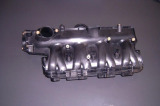 Energy conservation, safety, and environmental protection have become the three major themes for the development of the automotive industry. At the same time, they also propose urgent requirements for the automotive industry to reduce vehicle quality, reduce fuel consumption, increase structural strength, and improve NVH. In fact, the lightweighting of automobiles has become a trend in the development of the automotive industry worldwide. Therefore, the use of aluminum and magnesium materials is one of the most effective measures to reduce automobile emissions and improve fuel economy.
Energy conservation, safety, and environmental protection have become the three major themes for the development of the automotive industry. At the same time, they also propose urgent requirements for the automotive industry to reduce vehicle quality, reduce fuel consumption, increase structural strength, and improve NVH. In fact, the lightweighting of automobiles has become a trend in the development of the automotive industry worldwide. Therefore, the use of aluminum and magnesium materials is one of the most effective measures to reduce automobile emissions and improve fuel economy. According to statistics from the China Automotive Consultation Center, the use of aluminum instead of traditional steel manufacturing cars can reduce vehicle weight by 30-40%, make engines that can reduce weight by 30%, and aluminum radiators by 20% compared to the same copper products. 40%, aluminum car body is lighter than the original steel products by more than 40%. Therefore, the use of aluminum instead of cast iron and steel to manufacture auto parts will have a significant effect on weight reduction. For every kilogram of aluminum used in automobiles, the weight can be reduced by 2.25kg, and the weight reduction effect can reach 125%. At the same time, the entire service life of the car During the period, 20 kg of exhaust emissions can be reduced. Under the impetus of the general trend of vehicle weight reduction, it can be expected that in the next 10 years, China's light metal casting market will have significant development.
At present, the proportion of aluminum and magnesium alloy castings in major casting producing countries is between 13% and 19%, and some countries (such as Italy) are as high as 30% to 40%, while China’s aluminum and magnesium alloy castings account for The proportion is less than 10%. The lightweighting of automobiles is contributing to the continuous innovation in the forming methods and connection technologies of the automotive industry in China, and lightweight materials are also being continuously developed. However, unfortunately, the favorable policies relating to the lightweighting of automobiles have not been introduced yet. Consumers' awareness of vehicle weight reduction is not deep enough, and some consumer's consumption concepts still remain in the stage where the car body is heavier and safer.
Two Dimentional Drainage Planar
Geonet can be used as a kind of filling layers for stabilization, detritus separation, horizontal drainage cushion, underwater drainage constructure and slope road protection structure in building roads, railway, ports, airports, mining, hydro-power engineering projects.
Chief specifications include CE121.CE131.CE151.CE181.DN1.HF10
1. It reinforce old asphalt concrete road surface and asphalt layer, and prevents damage ;
2. It is used for rebuilding cement concrete road surface into composite road surface and restraining reflection caused by block contraction .
3. It is used in road expansion and improvment project and crack caused by old and new combination position and uneven sedimentation ;
4. It is used in soft soil base reinforcement treatment , is favorable for soft soil water separation and concretion,restrains sedimentation effectivly,distributes stress uniformly and improve overall strength of road base;
5. It is sued for preventing contraction crack caused by new road semi-rigid base layer,and reinforces and prevents road surface crack caused by foundation crack reflection.
Drainage Planar, Underwater Drainage HDPE Geonet,Two Dimntional Geonet, Two Dimentional Drainage Planar
Feicheng Lianyi Engineering Plastics Co., Ltd , https://www.lianyigeosynthetics.com
![<?echo $_SERVER['SERVER_NAME'];?>](/template/twentyseventeen/skin/images/header.jpg)